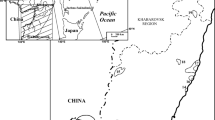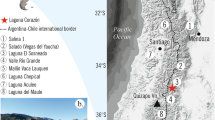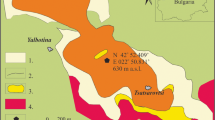Abstract
Today, Northeastern India receives some of the highest annual rainfall totals globally. The major portion of annual precipitation in this region falls during the Indian Summer Monsoon season (June–September); however, this region also receives a significant amount of rainfall during the pre-monsoon season (March–May). Here, we quantitatively reconstruct the climate of the Upper Siwalik subgroup, eastern Himalayan region, based on fossil assemblages using the Coexistence Approach (CA). The age of the fossil assemblage is considered to be late Pliocene–early Pleistocene. Data reconstructed for the present-day and past pre-monsoon rainfall in Northeastern India indicate an increasing trend since the late Miocene–early Pliocene. During the late Pliocene–early Pleistocene (Upper Siwalik), the temperature seasonality between warm (27–28.1 °C) and cold months (22–23.6 °C) was less pronounced compared with present-day warm (27–27.7 °C) and cold (14.8–15.4 °C) months conditions at the fossil locality. The reconstructed rainfall data indicate a monsoonal type of climate having a strong seasonality in wet and dry seasons during the deposition of the Upper Siwalik sediments. Moreover, composition of the fossil floras and reconstructed palaeoclimate suggest a vegetation shift from dominantly wet evergreen to semi-evergreen at the fossil locality, coincident with an increase in length of the dry season. The comparison of reconstructed CA data and climate modelling data of a Gelasian time slice with that of previously reconstructed climate data by using Climate Leaf Analysis Multivariate Programme (CLAMP) analysis of the late Pliocene–early Pleistocene (Upper Siwalik) fossils of the same locality provides nearly the identical result. Furthermore, all the reconstructed data indicate a monsoonal type of climate during the deposition of the Upper Siwalik sediments.












Similar content being viewed by others
References
Agrawal, R. P., Srivastava, A. K., & Maithani, A. (1991). Geology of the eastern Himalayan foothill belt of Bhutan and Arunachal Pradesh: An overview. Himalayan Geology, 2, 197–205.
Anand-Prakash, & Singh, T. (2000). Nature, composition, rank (maturation) and depositional environment of Siwalik coals from Arunachal Himalaya. Himalayan Geology, 21, 17–29.
Awasthi, N. (1992). Changing patterns of vegetation through Siwalik succession. Palaeobotanist, 40, 312–327.
Bera, S., & Khan, M. (2009). Record of fruit and leaflet cf. Pongamia pinnata (L.) Pierre from the upper Siwalik sediments (Kimin Formation) of Arunachal Pradesh. In S. Mondal & S. Bhattacharya (Eds.) Advances in Plant Biology. D. Bhattacharya Birth Centenary Commemorative Volume (pp. 432–441). Berlin: Springer.
Bera, S., De, A., & De, B. (2004). First record of Elaeocarpus Linn. Fruits from the Upper Siwalik sediments (Kimin Formation) of Arunachal Pradesh, India. Journal of the Geological Society of India, 64, 350–352.
Bera, S., Gupta, S., Khan, M. A., De, A., & Mukhopadhyay, R. (2014). First megafossil evidence of cyatheaceous tree fern from the Indian Cenozoic. Journal of Earth System Science, 123, 1433–1438. https://doi.org/10.1007/s12040-014-0460-x.
Bondarenko, O. V., Blokhina, N. I., & Utescher, T. (2013). Quantification of Calabrian climate in southern Primory'e, Far East of Russia—An integrative case study using multiple proxies. Palaeogeography Palaeoclimatology Palaeoecology, 386, 445–458. https://doi.org/10.1016/j.palaeo.2013.06.014.
Chaloner, W. G., & Creber, G. T. (1990). Do fossil plants give a climatic signal? Journal of the Geological Society of London, 147, 343–350. https://doi.org/10.1144/gsjgs.147.2.0343.
Champion, H. G., & Seth, S. K. (1968). The Forest types of India. Delhi: Manager of Publications.
Chirouze, F., Dupont-Nivet, G., Huyghe, P., van der Beek, P., Chakraborti, T., Bernet, M., & Erens, V. (2012). Magnetostratigraphy of the Neogene Siwalik Group in the far eastern Himalaya: Kameng section, Arunachal Pradesh, India. Journal of Asian Earth Sciences, 44, 117–135. https://doi.org/10.1016/j.jseaes.2011.05.016.
Corlett, R. T., & Primack, R. B. (2011). Tropical rain forest: An ecological and biogeographical comparison. Chichester: Wiley-Blackwell.
Das, A., Ghosh, P. K., Choudhury, B. U., Patel, D. P., Munda, G. C., Ngachan, S. V., & Chowdhury, P. (2009). Climate change in Northeast India: Recent facts and events-worry for agricultural management. In S. Panigrahy, S. S. Ray, & J. S. Parihar (Eds.) Impact of climate change on agriculture (Vol. XXXVIII-8/W3). Ahmedabad: International Society for Photogrammetry and Remote Sensing Archives.
Ding, L., Spicer, R. A., Yang, J., Xu, Q., Cai, F., Li, S., Lai, Q., Wang, H., Spicer, T. E. V., Yue, Y., Shukla, A., Srivastava, G., Khan, M. A., Bera, S., & Mehrotra, R. (2017). Quantifying the rise of the Himalaya orogen and implications for the south Asian monsoon. Geology, 45, 215–218. https://doi.org/10.1130/g38583.1.
Farnsworth, A., Lunt, D. J., Robinson, S. A., Valdes, P. J., Roberts, W. H. G., Clift, P., Markwick, P., Tao, S., Wrobel, N., Bragg, F., Kelland, S.-J., & Pancost, R. D. (2019). Past east Asian monsoon evolution controlled by paleogeography, not CO2. Science Advances, 5, eaax1697.
Fick, S. E., & Hijmans, R. J. (2017). Worldclim 2: New 1-km spatial resolution climate surfaces for global land areas. International Journal of Climatology, 37, 4302–4315. https://doi.org/10.1002/joc.5086.
Hajra, P. K., Verma, D. M., & Giri, G. S. (1996). Materials for the Flora of Arunachal Pradesh, first volume. Calcutta: Botanical Survey of India.
Hickey, L. J. (1977). Stratigraphy and paleobotany of the Golden Valley Formation (early Tertiary) of western North Dakota. Memoir - Geological Society of America, 150, 1–183.
Joshi, A., & Chakraborty, P. P. (2001). Systematic geological mapping in parts of East and West Kameng districts, Arunachal Pradesh. Geological Survey of India. Unpublished Progress Report for Field Session 1999–2000.
Joshi, A., Mehrotra, R. C., & De, A. (2003a). A fossil wood from the Upper Siwalik sediments of West Kameng District, Arunachal Pradesh, India. In The Director General (Ed.) Proceedings of the Fourth South Asia Geological Congress (GEOSAS - IV) (pp. 312–315). Kolkata: Geological Survey of India.
Joshi, A., Tewari, R., Mehrotra, R. C., Chakraborty, P. P., & De, A. (2003b). Plant remains from the Upper Siwalik sediments of West Kameng District, Arunachal Pradesh, India. Journal of the Geological Society of India, 61, 319–324.
Kalnay, E., Kanamitsu, M., Kistler, R., Collins, W., Deaven, D., Gandin, L., Iredell, M., Saha, S., White, G., Woollen, J., & Zhu, Y. (1996). The NCEP/NCAR 40-year reanalysis project. Bulletin of the American Meteorological Society, 77(3), 437–472. https://doi.org/10.1175/15200477(1996)077<0437:TNYRP>2.0.CO;2.
Kanjilal, U. N., Kanjilal, P. C., & Das, A. (1934). Flora of Assam: Volume 1. Calcutta: Prabasi Press.
Karunakaran, C., & Ranga Rao, A. (1979). Status of exploration for hydrocarbons in the Himalayan region – Contributions to stratigraphy and structure. Geological Survey of India, Miscellaneous Publication, 41, 1–66.
Kaul, R. N., & Haridasan, K. (1987). Forest types of Arunachal Pradesh—A preliminary study. Journal of Economic and Taxonomic Botany, 9, 379–389.
Khan, M., Ghosh, R., Bera, S., Spicer, R. A., & Spicer, T. E. V. (2011). Floral diversity during Plio-Pleistocene Siwalik sedimentation (Kimin Formation) in Arunachal Pradesh, India, and its palaeoclimatic significance. Palaeodiversity and Palaeoenvironments, 91, 237–255. https://doi.org/10.1007/s12549-013-0127-7.
Khan, M. A., Spicer, T. E. V., Spicer, R. A., & Bera, S. (2014a). Occurrence of Gynocardia odorata R. Br. (Achariaceae, formerly Flacourtiaceae) from the Plio-Pleistocene sediments of Arunachal Pradesh, Northeast India and its palaeoclimatic and phytogeographic significance. Review of Palaeobotany and Palynology, 211, 1–9. https://doi.org/10.1016/j.revpalbo.2014.10.002.
Khan, M. A., Spicer, R. A., Bera, S., Ghosh, R., Yang, J., Spicer, T. E. V., Guo, S.-X., Su, T., Jacques, F. M. B., & Grote, P. J. (2014b). Miocene to Pleistocene floras and climate of the eastern Himalayan Siwaliks, and new palaeoelevation estimates for the Namling-Oiyug Basin, Tibet. Global and Planetary Change, 113, 1–10. https://doi.org/10.1016/j.gloplacha.2013.12.003.
Khan, M. A., Bera, S., Ghosh, R., Spicer, R. A., & Spicer, T. E. V. (2015). Leaf cuticular morphology of some angiosperm taxa from the Siwalik sediments (middle Miocene to lower Pleistocene) of Arunachal Pradesh, eastern Himalaya: Systematic and palaeoclimatic implications. Review of Palaeobotany and Palynology, 214, 9–26. https://doi.org/10.1016/j.revpalbo.2014.10.008.
Khan, M. A., Bera, M., Spicer, R. A., Spicer, T. E. V., & Bera, S. (2017). First occurrence of mastixioid (Cornaceae) fossil in India and its biogeographic implications. Review of Palaeobotany and Palynology, 247, 83–96. https://doi.org/10.1016/j.revpalbo.2017.08.006.
Kiew, R., Chung, R. C. K., Saw, L. G., & Soepadmo, E. (2018). Flora of peninsular Malaysia. Series II: Seed plants. Volume 7. Malayan Forest Records, 49, 1–321.
Klaus, S., Morley, R. J., Plath, M., Zhang, Y.-P., & Li, J.-T. (2015). Biotic interchange between the Indian subcontinent and mainland Asia through time. Nature Communications, 7, 12132. https://doi.org/10.1038/ncomms12132.
Kumar, G. (1997). Geology of Arunachal Pradesh. Bangalore: Geological Society of India.
Kumar, M. N., Bose, J., & Roy, R. K. (1983). Geomorphology and Quaternary geology of Dikrang Basin, Subansiri district, Arunachal Pradesh with special reference to the hydrogeological characteristics of Alluvium sediments. Geological Survey of India, Miscellaneous Publication, 43, 77–81.
Kunte, S. V., Ganju, J. L., & Dutta, N. K. (1983). Geology and structure of the Tertiary belt between Bargang and Pachin rivers, Arunachal Pradesh. Geological Survey of India, Miscellaneous Publication, 43, 124–129.
Lau, K. M., & Yang, S. (1997). Climatology and interannual variability of the southeast Asian summer monsoon. Advances in Atmospheric Sciences, 14, 141–162. https://doi.org/10.1007/s00376-997-0016-y.
Liang, M., Bruch, A., Collinson, M. E., Mosbrugger, V., Li, C.-S., Sun, Q., & Hilton, J. (2003). Testing the climatic signals from different palaeobotanical methods: An example from the middle Miocene Shanwang flora of China. Palaeogeography Palaeoclimatology Palaeoecology, 198, 279–301. https://doi.org/10.1016/s0031-0182(03)00471-1.
Lunt, D. J., Farnsworth, A., Loptson, C., Foster, G. L., Markwick, P., O’Brien, C. L., Pancost, P. D., Robinson, S. A., & Wrobel, N. (2016). Palaeogeographic controls on climate and proxy interpretation. Climate of the Past, 12, 1181–1198.
MacGinitie, H. D. (1941). A middle Eocene flora from the Central Sierra Nevada. Carnegie Institute of Washington. Publication, 534, 1–94.
Mahanta, R., Sarma, D., & Choudhury, A. (2013). Heavy rainfall occurrences in Northeast India. International Journal of Climatology, 33, 1456–1469. https://doi.org/10.1002/joc.3526.
Mosbrugger, V. (1999). The nearest living relative method. In T. P. Jones & N. P. Rowe (Eds.) Fossil plants and spores modern techniques (pp. 261–265). London: Geological Society.
Mosbrugger, V., & Utescher, T. (1997). The coexistence approach—A method for quantitative reconstructions of Tertiary terrestrial palaeoclimate data using plant fossils. Palaeogeography Palaeoclimatology Palaeoecology, 134, 61–86. https://doi.org/10.1016/s0031-0182(96)00154-x.
Mosbrugger, V., Utescher, T., & Dilcher, D. L. (2005). Cenozoic continental climatic evolution of Central Europe. Proceedings of the National Academy of Sciences, USA, 102, 14964–14969. https://doi.org/10.1073/pnas.0505267102.
Pilgrim, G. E. (1910). Preliminary note on a revised classification of the Tertiary fresh-water deposits of India. Records of the Geological Survey of India, 40, 185–205.
Pilgrim, G. E. (1913). The correlation of the Siwalik with mammal horizons of Europe. Records of the Geological Survey of India, 43, 264–326.
Proctor, J., Haridasan, K., & Smith, G. W. (1998). How far north does lowland evergreen tropical forest go? Global Ecology and Biogeography, 7, 141–146. https://doi.org/10.2307/2997817.
Ranga Rao, A. (1983). Geology and hydrocarbon potential of a part of Assam-Arankan Basin and its adjacent region. Petroleum Asia Journal, 4, 127–158.
Singh, T. (2007). Geology of Itanagar capital complex, Arunachal Himalaya, with special reference to neotectonics. Journal of the Geological Society of India, 70, 339–352.
Singh, T., & Tripathi, S. K. M. (1990). Siwalik sediments of Arunachal Himalaya: Palynology, palaeoecology and palaeogeography. Palaeobotanist, 38, 325–332.
Spicer, R. A., Ahlberg, A., Herman, A. B., Hofmann, C.-C., Raikevich, M., Valdes, P. J., & Markwick, P. J. (2008). The Late Cretaceous continental interior of Siberia: A challenge for climate models. Earth and Planetary Science Letters, 267, 228–235.
Spicer, R. A., Bera, S., De Bera, S., Spicer, T. E. V., Srivastava, G., Mehrotra, R., Mehrotra, N., & Yang, J. (2011). Why do foliar physiognomic climate estimates sometimes differ from those observed? Insights from taphonomic information loss and a CLAMP case study from the Ganges Delta. Palaeogeography Palaeoclimatology Palaeoecology, 302, 381–395. https://doi.org/10.1016/j.palaeo.2011.01.024.
Spicer, R. A., Yang, J., Herman, A. B., Kodrul, T., Maslova, N., Spicer, T. E. V., Aleksandrova, G. N., & Jin, J. (2016). Asian Eocene monsoons as revealed by leaf architectural signatures. Earth and Planetary Science Letters, 449, 61–68. https://doi.org/10.1016/j.epsl.2016.05.036.
Spicer, R. A., Yang, J., Herman, A. B., Kodrul, T., Aleksandrova, G., et al. (2017). Paleogene monsoons across India and South China: Drivers of biotic change. Gondwana Research, 49, 350–363. https://doi.org/10.1016/j.gr.2017.06.006.
Srivastava, G., & Mehrotra, R. C. (2010). Tertiary flora of Northeast India vis-à-vis movement of the Indian plate. Memoirs of the Geological Society of India, 75, 123–130.
Srivastava, G., & Mehrotra, R. C. (2012). The oldest fossil of Semecarpus L.f. from the Makum Coalfield, Assam, India and comments on its origin. Current Science, 102, 398–400.
Srivastava, G., Spicer, R. A., Spicer, T. E. V., Yang, J., Kumar, M., Mehrotra, R. C., & Mehrotra, N. C. (2012). Megaflora and palaeoclimate of a late Oligocene tropical delta, Makum Coalfield, Assam: Evidence for the early development of the South Asia monsoon. Palaeogeography Palaeoclimatology Palaeoecology, 342-343, 130–142. https://doi.org/10.1016/j.palaeo.2012.05.002.
Srivastava, G., Trivedi, A., Mehrotra, R. C., Paudayal, K. N., Limaye, R. B., Kumaran, K. P. N., & Yadav, S. K. (2016). Monsoon variability over peninsular India during late Pleistocene: Signatures of vegetation shift recorded in terrestrial archive from the corridors of Western Ghats. Palaeogeography Palaeoclimatology Palaeoecology, 443, 57–65. https://doi.org/10.1016/j.palaeo.2015.11.045.
Srivastava, G., Tiwari, R. P., & Mehrotra, R. C. (2017). Quantification of rainfall during the late Miocene–early Pliocene in north East India. Current Science, 113, 2253–2257.
Srivastava, G., Mehrotra, R. C., & Srikarni, C. (2018a). Fossil wood flora from the Siwalik Group of Arunachal Pradesh, India and its climatic and phytogeographic significance. Journal of Earth System Science, 127, 6. https://doi.org/10.1007/s12040-017-0903-2.
Srivastava, G., Mehrotra, R. C., & Srikarni, C. (2018b). Lagerstroemia L. wood from the Kimin Formation (Upper Siwalik) of Arunachal Pradesh and its climatic and phytogeographic significance. Journal of the Geological Society of India, 91, 695–699. https://doi.org/10.1007/s12594-018-0925-7.
Srivastava, G., Paudayal, K. N., Utescher, T., & Mehrotra, R. C. (2018c). Miocene vegetation shift and climate change: Evidence from the Siwalik of Nepal. Global and Planetary Change, 161, 108–120. https://doi.org/10.1016/j.gloplacha.2017.12.001.
Tandon, S. K. (1991). The Himalayan foreland: Focus on Siwalik basin. In S. K. Tandon, C. C. Pant, & S. M. Casshyap (Eds.), Sedimentary basins of India: Tectonic context (pp. 177–201). Nainital: Gyanodaya Prakashan.
Tandon, K. N., & Purkayastha, S. K. (1958). Family Guttiferae. In K. A. Chowdhury & S. S. Ghosh (Eds.), Indian woods 1 (pp. 69–85). Delhi: The Manager of Publications.
Uhl, D., Klotz, S., Traiser, C., Thiel, C., Utescher, T., Kowalski, E., & Dilcher, D. L. (2007). Cenozoic paleotemperatures and leaf physiognomy—A European perspective. Palaeogeography Palaeoclimatology Palaeoecology, 248, 24–31. https://doi.org/10.1016/j.palaeo.2006.11.005.
Utescher, T., & Mosbrugger, V. (2018). The Palaeoflora database. www.palaeoflora.de.
Utescher, T., Bruch, A. A., Erdei, B., François, L., Ivanov, D., Jacques, F. M. B., et al. (2014). The Coexistence Approach – theoretical background and practical considerations of using plant fossils for climate quantification. Palaeogeography Palaeoclimatology Palaeoecology, 410, 58–73. https://doi.org/10.1016/j.palaeo.2014.05.031.
Utescher, T., Bondarenko, O. V., & Mosbrugger, V. (2015). The Cenozoic cooling–continental signals from the Atlantic and Pacific side of Eurasia. Earth and Planetary Science Letters, 415, 121–133. https://doi.org/10.1016/j.epsl.2015.01.019.
Valdes, P., Armstrong, E., Badger, M. P. S., Bradshaw, C. D., Bragg, F., Crucifix, M., et al. (2017). The BRIDGE HadCM3 family of climate models: HadCM3@Bristol v1.0. Geoscientific Model Development, 10, 3715–3743.
Valdiya, K. S. (2002). Emergence and evolution of Himalaya: Reconstructing history in the light of recent studies. Progress in Physical Geography, 26, 360–399. https://doi.org/10.1191/0309133302pp342ra.
Vögeli, N., Najman, Y., van der Beek, P., Huyghe, P., Wynn, P. M., Govin, G., et al. (2017). Lateral variations in vegetation in the Himalaya since the Miocene and implications for climate evolution. Earth and Planetary Science Letters, 471, 1–9. https://doi.org/10.1016/j.epsl.2017.04.037.
Wang, B., Liu, J., Kim, H. J., Webster, P. J., & Yim, S. Y. (2012). Recent change of the global monsoon precipitation (1979–2008). Climate Dynamics, 39, 1123–1135.
Wolfe, J. A. (1993). A method of obtaining climatic parameters from leaf assemblages. United States Geological Survey Bulletin, 2040, 1–73.
Xing, Y. W., Utescher, T., Jacques, F. M. B., Tao, S., Liu, Y. S., Huang, Y. J., & Zhou, Z. K. (2012). Palaeoclimatic estimation reveals a weak winter monsoon in southwestern China during the late Miocene: Evidence from plant macrofossils. Palaeogeography Palaeoclimatology Palaeoecology, 358-360, 19–26. https://doi.org/10.1016/j.palaeo.2012.07.011.
Yang, J., Spicer, R. A., Spicer, T. E. V., Arens, N. C., Jacques, F. M. B., Su, T., Kennedy, E. M., Herman, A. B., Steart, D. C., Srivastava, G., Mehrotra, R. C., Valdes, P. J., Mehrotra, N. C., Zhou, Z., & Lai, J. (2015). Leaf form–climate relationships on the global stage: An ensemble of characters. Global Ecology and Biogeography, 24, 1113–1125. https://doi.org/10.1111/geb.12334.
Zhang, S. P., & Wang, B. (2008). Global monsoon summer rainy seasons. International Journal of Climatology, 28, 1563–1578. https://doi.org/10.1002/joc.1659.
Acknowledgements
GS, HB, RCM and MS are thankful to the Director, Birbal Sahni Institute of Palaeosciences, Lucknow for providing necessary facilities of the present research work. The authors are thankful to Prof. R.A. Spicer, Open University, UK, and one anonymous reviewer for their constructive suggestions. This work is a contribution to NECLIME (Neogene Climate Evolution of Eurasia).
Funding
AF and PJV acknowledge funding from NERC through NE/K014757/1, NE/I005722/1, NE/I005714/1, and (PJV also) NE/P013805/1. GS acknowledge the Chinese Academy of Sciences President’s International Fellowship Initiative number 2018VMC0005.
Author information
Authors and Affiliations
Corresponding author
Ethics declarations
Conflict of interest
The authors declare that they have no conflict of interest.
Additional information
Publisher’s note
Springer Nature remains neutral with regard to jurisdictional claims in published maps and institutional affiliations.
This article is a contribution to the special issue “Palaeobotanical contributions in honour of Volker Mosbrugger".
Rights and permissions
About this article
Cite this article
Srivastava, G., Farnsworth, A., Bhatia, H. et al. Climate and vegetation change during the Upper Siwalik—a study based on the palaeobotanical record of the eastern Himalaya. Palaeobio Palaeoenv 101, 103–121 (2021). https://doi.org/10.1007/s12549-020-00457-w
Received:
Revised:
Accepted:
Published:
Issue Date:
DOI: https://doi.org/10.1007/s12549-020-00457-w





